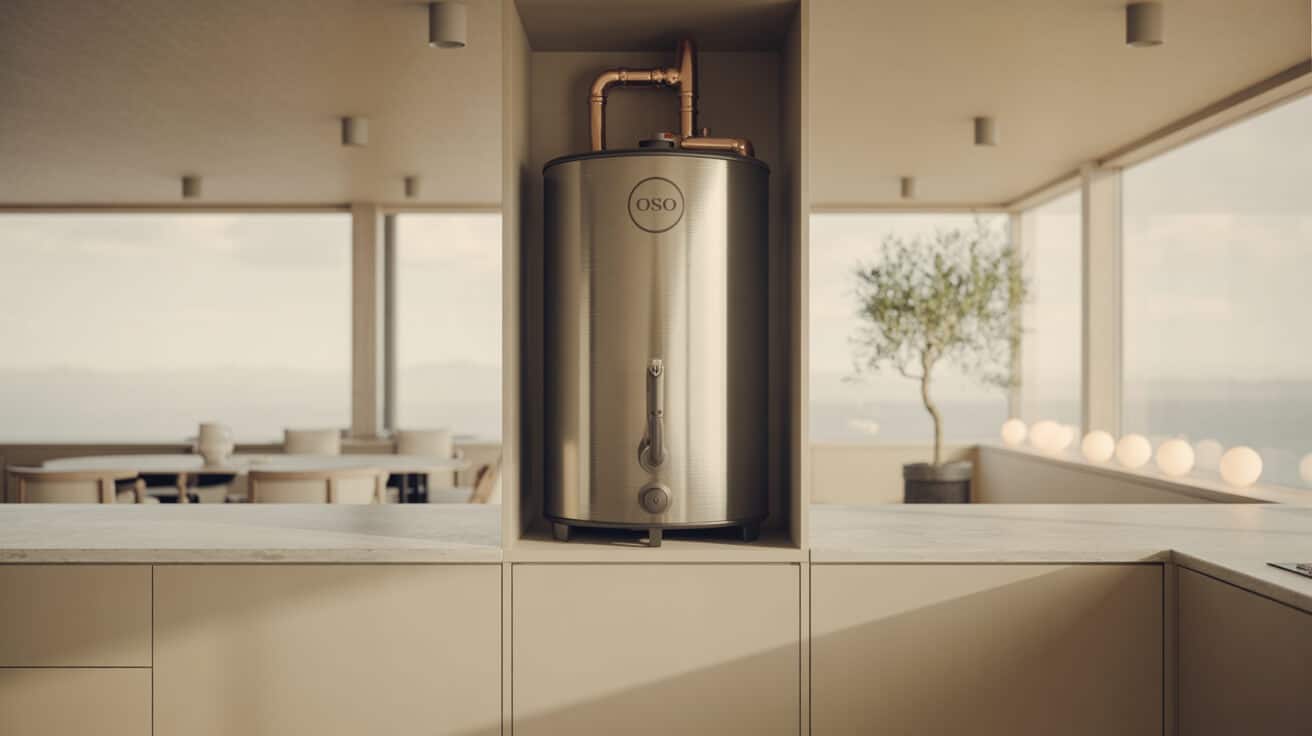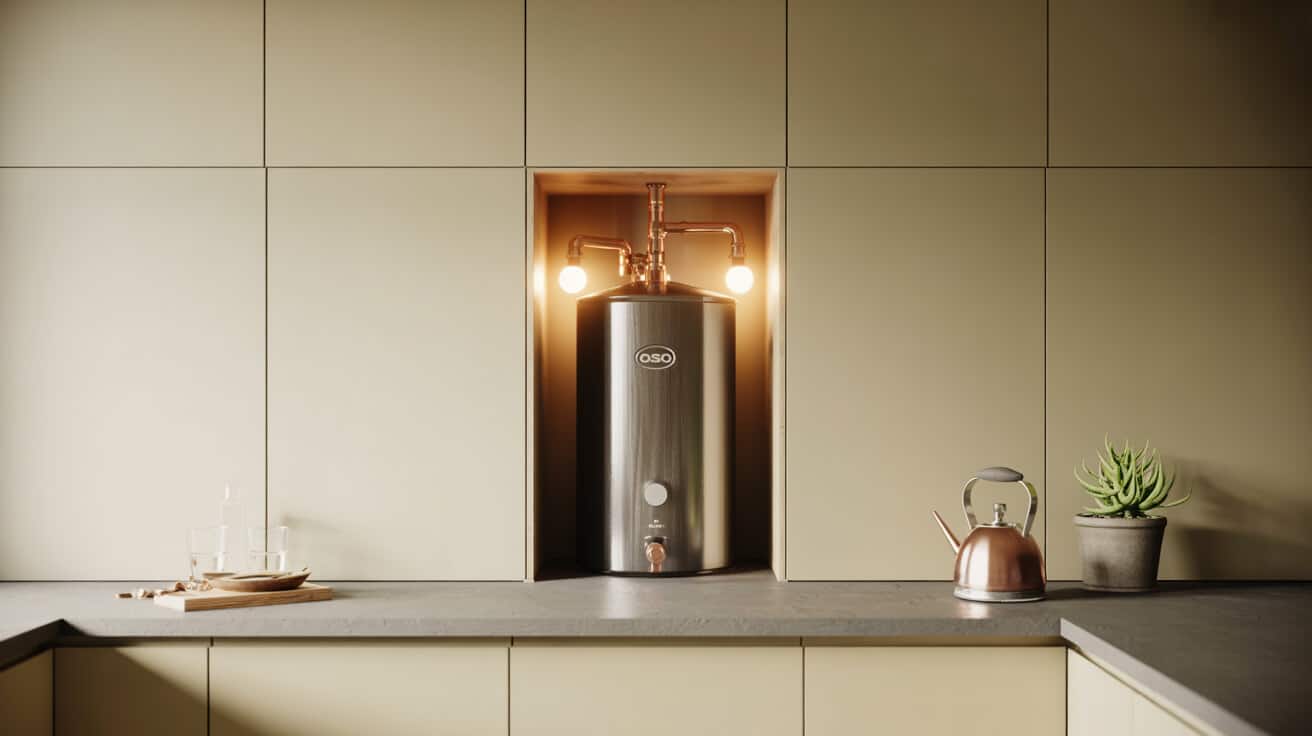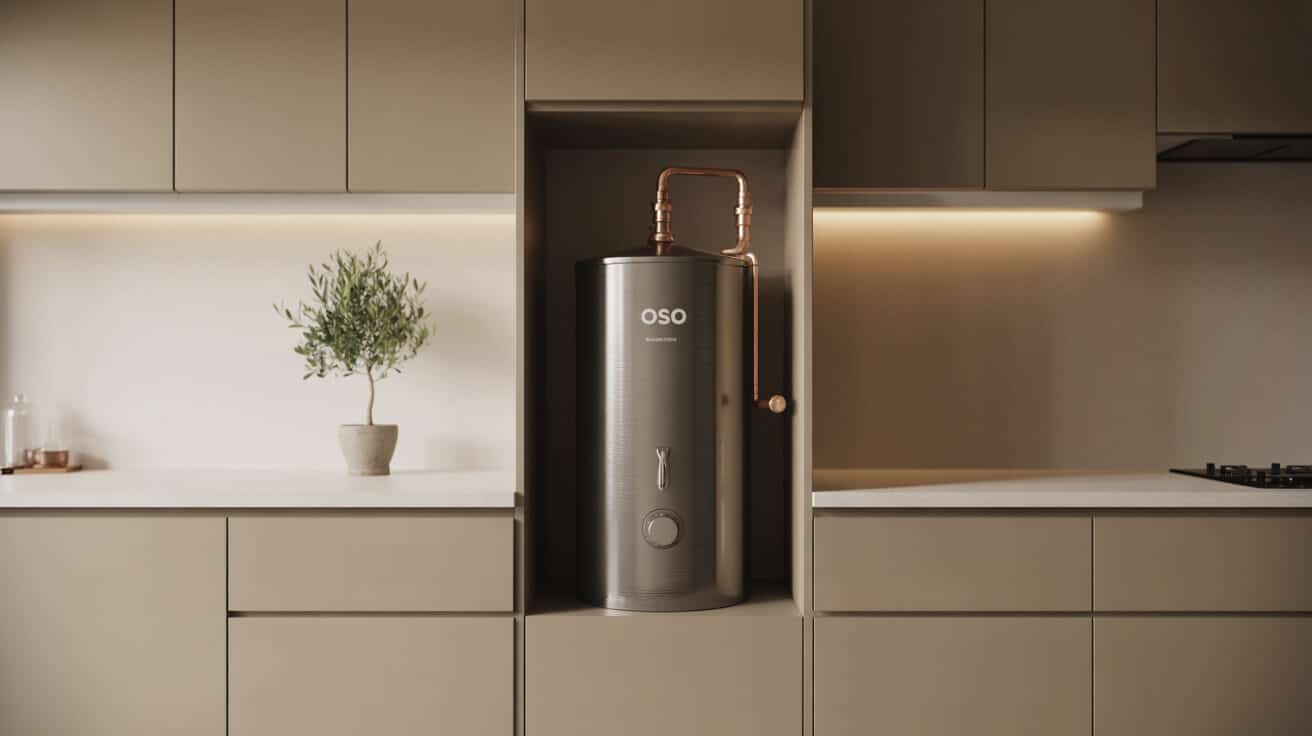The OSO Hotwater cylinder operates as the central hub of a property’s hot water delivery system, maintaining steady mains pressure and a predictable temperature at every outlet. The adoption of robust manufacturing standards—such as high-grade duplex stainless steel, seamless welds, and durable insulation—ensures the long-term resilience and performance of these cylinders. OSO’s product lines are recognised for their compatibility with a spectrum of heating technologies, including traditional boilers, electric immersion elements, and renewable energy sources like solar thermal collectors and air source heat pumps.
Across the European market and within the United Kingdom, OSO Hotwater cylinders are specified for their ability to meet stringent building codes, water safety regulations, and energy performance directives. Property owners, managers, and contractors value the modularity and flexibility present in the OSO portfolio, with available sizes ranging from compact domestic models suitable for flats to commercial-scale systems designed for hotels, hospitals, and educational installations. Services offered by Plumbers 4U and similar certified installers routinely encompass specification, installation, annual servicing, and troubleshooting of these cylinders, providing a complete solution for your organisation’s needs.
Etymology or name origin
“OSO Hotwater” derives from the company’s Norwegian origins and central focus on innovation in water heating technologies. The brand name OSO references the firm’s founding lineage, while “Hotwater” signals its dedication to delivering efficient and reliable hot water storage products. In industry parlance, the phrase “unvented cylinder” describes OSO’s approach to water storage—pressurised, sealed systems that connect directly to the mains and do not require atmospheric venting tanks, thereby marking a decisive evolution from traditional vented storage.
Adoption of OSO’s product nomenclature in professional engineering and property development contexts has contributed to a broader transformation in hot water system specification. Common terms such as “direct cylinder,” “indirect coil,” “twin coil,” “pre-plumbed,” and “buffer tank” now carry specific structural and functional implications across the plumbing and building services community.
Overview / Context
Modern building infrastructure demands efficient, safe, and scalable hot water storage systems, and OSO Hotwater cylinders are designed to fulfil these multi-dimensional requirements. In domestic environments, they underpin reliable shower and bathing experiences, while in commercial premises, they facilitate the consistent delivery of hygienic hot water to large populations.
Domestic and commercial applications
OSO cylinders are installed in a wide range of property types: independent houses, flats, social housing, hotels, healthcare facilities, and educational estates. Their versatility lies in engineered compatibility with both new-build and retrofitted heating architectures. Within a typical home, you may rely on your cylinder for pressurised hot water at multiple taps simultaneously, superior energy efficiency, and a reduced risk of bacterial contamination, especially if integrated with anti-legionella safety cycles.
In larger, more complex environments—such as leisure centres or student accommodations—commercial cylinder variants provide the thermal capacity and safety controls needed for high peak demand, multiple distribution zones, and critical compliance with statutory hazard prevention.
Market and company overview
OSO Hotwater is a Scandinavian manufacturer with international distribution, including a strong presence in the UK through OSO UK. The company’s reputation is built on technical leadership in cylinder design, quality assurance, and compliance infrastructure. Distribution networks often include national merchants such as Plumbers 4U’s supplier base, facilitating widespread access for property managers and trade professionals.
A robust aftercare and documentation programme underpins OSO’s position among developers, landlords, and facilities managers seeking reassurance around lifespan, warranty, and suitability for grant-supported building upgrades. OSO’s commitment to sustainability is reflected in the recyclability of product materials, the adoption of eco-foam insulation, and manufacturing certification under ISO 14001.
Role in energy and building regulations
The United Kingdom’s Building Regulations Part G specifies safety and hygiene in hot water supply, while Part L governs energy performance. Modern OSO cylinders are designed for full compliance with these standards, supported by certifications from WRAS (Water Regulations Advisory Scheme), KIWA, CE, and the Energy-related Products (ERP) Directive. Building control notifications, G3 installer certifications, and mandatory commissioning logbooks ensure both legal compliance and system auditability for your organisation.
Products are further optimised for integration with renewable heat incentives and energy performance certification, providing advantages in both operational running costs and asset value enhancement.
History
Origins and early development
Founded in Norway in the mid-20th century, OSO Hotwater initially focused on creating corrosion-resistant water heaters designed for harsh, mineral-rich water conditions. Early research and development led to industry innovations in tank construction, specifically the use of precision-welded stainless steel shells over traditional copper or enamelled steel.
Entry into the UK market and regulations
By the 1980s, regulatory relaxation in the UK allowed sealed, unvented systems as long as they incorporated strict safety features. OSO adapted its models to comply with British Standards, integrating expansion vessels, pressure relief valves, and visible tundish discharge points fundamental to G3 compliance. Penetration into the UK market was accelerated by shifts in housing design and the growing prevalence of combination boilers and megaflow systems.
OSO’s range was expanded to meet UK property requirements by reducing minimum installation footprints, designing for narrow airing cupboards, and providing product documentation for landlords, builders, and local authorities.
Recent developments and product line extensions
Environmental regulation in the 21st century fueled the introduction of the Super, Eco, and Slimline series. Innovations included built-in expansion vessels (reducing external pipework), pre-plumbed pipe arrays for faster installation, and foam insulation that exceeded ERP minimum requirements. These enhancements enabled OSO cylinders to be specified in grant-eligible refurbishments, smart home installations, and district heating schemes.
Recent advances have centred on maximising system modularity: the capacity to connect with solar thermal, district heating, or renewable hybrids, and to simplify lifecycle servicing by property managers.

Concept / Description
OSO Hotwater cylinders are sealed storage vessels engineered for both the short-term retention and rapid delivery of heated water at mains pressure. Their structural design typically features:
- A high-grade duplex stainless steel tank, chosen for its ability to resist corrosion and endure cyclical pressurisation.
- Factory-applied polyurethane foam insulation, designed to minimise standing heat losses and maintain regulatory compliance.
- A dedicated expansion vessel—either integrated or external—to absorb increased water volume during heating events, thus preventing system overpressurization.
- Internal service access panels that facilitate inspection, maintenance, and descaling without system removal.
Cylinder materials and insulation
Stainless steel constitutes the structural wall of the OSO cylinder due to its high resistance to scaling, pitting, and mechanical stress. Polyurethane or comparable eco-foam insulation maintains stable water temperature and mitigates thermal bridging. Product lines aimed at sustainability feature increased insulation thickness, minimising environmental load and operational energy cost for your company or organisation.
Component overview
Key components include:
- Expansion vessel: Absorbs heating-induced volume increases.
- Temperature and pressure relief valve (TPRV): Discharges excess to prevent rupture.
- Tundish: Offers immediate visibility of discharge, alerting you to possible faults in real-time.
- Immersion heater: Acts as a primary or supplemental energy source.
- Coil heat exchanger(s): Separates the potable and heated/primary circuits in indirect models, ensuring system hygiene and maintenance simplicity.
- Secondary return connection: Enables circulation in multi-outlet systems, reducing dead legs and mitigating bacterial growth.
- Precise user controls and safety thermostats: Enhance usability and prevent energy wastage or scalding.
Model sizes and configurations
OSO Hotwater’s catalogue spans:
- Compact cylinders for properties with space constraints.
- Domestic models designed for typical households or multi-storey homes.
- Commercial cylinders with capacities up to and exceeding 1,000 litres.
- Horizontal and vertical mounting orientations for plantroom flexibility.
Function and operation
An OSO Hotwater cylinder reliably stores and distributes hot water at a pressure consistent with your incoming mains, thus supporting simultaneous multi-outlet usage across your property or business.
Operating principles
The cylinder operates by receiving pre-heated water from an external boiler, a solar collector, a heat pump, or an electric immersion heater. Upon demand, hot water exits the vessel, instantly replaced by a proportional volume of cold water, which is then heated via the primary coil or immersion element. Expansion is accommodated by the vessel; any pressure above the regulated threshold is safely relieved through the TPRV and delivered to a visible tundish.
System integration and compatibility
OSO cylinders are engineered for cross-compatibility:
- Traditional gas or oil boilers: (indirect models)
- Direct electric: immersion installations (for all-electric properties)
- Solar thermal collectors: and air source/ground source heat pumps (twin coil, renewables range)
- Underfloor heating or multiple-zoned domestic hot water loops:
When properly configured by certified engineers from providers such as Plumbers 4U, these cylinders seamlessly integrate into existing or new systems, aligning with both routine maintenance workflows and advanced energy-saving protocols.
Typical installer practices
Best practice installation involves:
- Survey of premises to establish capacity and system alignment.
- Selection of cylinder type (direct, indirect, twin coil) based on your energy sources and water demand.
- Installation of appropriate discharge pipework, insulation, and expansion equipment in compliance with G3 and WRAS.
- Full testing and commissioning, documented with a Benchmark or manufacturer-provided logbook.
Variants and product range
Domestic variants
- Direct models: Energy delivered exclusively by one or more immersion heaters. Often utilised in off-gas grid or electric-only buildings.
- Indirect models: Heat supplied via a coil from an external boiler, maximising efficiency and system hygiene.
- Twin coil and solar-ready units: Feature two distinct heat exchangers, enabling the synchronous or sequential use of renewable and primary sources.
- Slimline models: Reduced diameter for retrofit in tight airing cupboards or flats.
Commercial and industrial models
Commercial products deliver increased storage capacities, higher pressure tolerances, and greater resilience against temperature and pressure cycling. These units serve large-scale developments, housing blocks, or sites with special regulatory needs (e.g., Legionella risk controls).
Renewables and integration-ready types
With an increasing number of projects seeking compliance with decarbonization policy or to obtain public grants, OSO produces dedicated renewable cylinders. These models are optimised for low-grade heat sources and permit system zoning for maximum efficiency.
Installation and commissioning
Legal and regulatory frameworks
UK Building Regulations Part G and the related G3 schedule strictly govern the installation of unvented hot water storage. Any installation or service action must be undertaken by G3-certified engineers, with supporting documentation provided to the Local Authority Building Control office upon completion.
All cylinders and components must show WRAS and CE marking to verify conformity with potable water standards, as well as ERP labelling for energy efficiency.
Qualified installers
Installations performed by certified professionals, such as the team from Plumbers 4U, are distinguished by adherence to correct fixings, discharge pipework gradients, and anti-contamination design. The experience and training of G3 installers facilitate risk assessment and future maintenance.
Commissioning process
Standard commissioning steps comprise:
- Cleaning and flushing the cylinder and distribution networks.
- Verification of safety valves and discharge routes.
- Charging of expansion vessels and pressure tests.
- Operation of thermostats, immersion, and all primary/secondary heating sources.
- Completion and handover of the benchmark or manufacturer’s commissioning logbook.
Documentation and warranty
Failure to fully document installation and commissioning can render product warranties void and expose your property or company to enforcement actions. Routine maintenance logs are an essential record for both compliance and warranty support.

Maintenance and servicing
Recommended service interval
An annual service by a qualified provider is required to maintain compliance, warranty, and optimal operational efficiency. This includes expansion vessel inspection, descaling, TPRV function testing, and immersion heater evaluation.
Faults, diagnostics, and troubleshooting
Systematic diagnosis by engineers includes leak checks, pressure monitoring, evaluation of modulation cycles, and inspection of controls for wear or malfunction. Typical user-noticed issues—such as insufficient pressure, visible discharge, or unexplained temperature variation—are traced to a manageable set of mechanical causes.
Warranty and service coverage
OSO offers warranties that cover most manufacturing and component faults, subject to documented installation and compliant maintenance by authorised engineers. Plumbers 4U facilitates the linkage between you and the manufacturer for in-warranty service, troubleshooting, and supply of original spare parts.
Health, safety, and regulatory context
Hot water safety regulations
Critical safety functions, including temperature and pressure relief, visible discharge piping, anti-legionella cycles, and anti-scald technology, are all mandated by current UK and European regulations.
Product certifications
Products bear WRAS, CE, KIWA, and ERP certification, each guaranteeing compliance with potable water safety, energy efficiency, and system resilience. Certification requirements are updated regularly, prompting OSO and certified firms to continually review their installation and service programmes.
Owner and provider responsibilities
As the property or business owner, you are responsible for scheduling regular inspections and maintaining compliance records, while certified providers ensure all interventions are compliant and logged.
Performance and efficiency
Energy efficiency standards
ERP labelling and enhanced insulation ensure standing heat losses remain beneath legislative thresholds, maximising retention and reducing operational energy bills. Table 1 below summarises key performance metrics, with typical values drawn from ERP testing and manufacturer’s data.
| Model | Cylinder Volume (L) | ERP Class | Standing Heat Loss (W) | Warranty (years) |
|---|---|---|---|---|
| OSO Super Indirect 170L | 170 | B | <1.6 | 25 (shell) |
| OSO Eco Direct 210L | 210 | B | <1.7 | 25 (shell) |
| OSO Slimline Indirect | 150 | B | <1.8 | 25 (shell) |
| OSO Commercial 500L | 500 | A | <2.1 | 10 (shell) |
Market comparisons
OSO models regularly achieve or surpass industry means for pressure, corrosion resistance, and thermal performance. These features provide significant advantages to property managers and maintenance professionals, facilitating reduced lifecycle costs and simplifying compliance during building surveys.
Environmental and sustainability aspects
Product design emphasises recyclability, long service life, and minimization of harmful materials. Modern insulation materials further reduce lifecycle environmental impact, aligning with rapidly evolving local and national standards for sustainable construction.
Challenges / barriers / limitations
Operational or technical challenges
- Incorrectly sized or installed cylinders may lead to chronic discharge, insufficient hot water, or heightened risk of failure.
- In hard water areas, limescale accumulation can impact element efficiency and pressure regulation; remedial action is typically rapid if scheduled as part of regular service.
- Limited property access or retrofitting constraints may hinder installation of large commercial units.
User/owner issues and troubleshooting
- Overlooking annual service can result in loss of manufacturer’s warranty and increased failure risk.
- Failure to routinely check the tundish or pressure relief discharge can delay identification of critical system issues.
Market and supply chain considerations
Spare part lead times and fluctuations in industry material costs may occasionally complicate urgent maintenance needs, especially in large or geographically dispersed estates.
Compliance gaps
Failure to adhere to G3 guidelines or improper documentation during installation or service can result in local authority enforcement action and legal exposure for your business or properties.
Impact / influence / legacy
OSO Hotwater cylinders set long-term benchmarks for hot water storage reliability, energy stewardship, and compliance, shaping both everyday property outcomes and wider regulatory evolution.
Influence on regulation
Sustained engineering collaboration between OSO and policymakers has informed the drafting and continuous refinement of water safety, efficiency, and renewable heat standards in the UK and EU.
Adoption in new technology and standards
The modularity and forward compatibility of the product line enable you to integrate future heat sources and controls, creating long-lived, sustainable infrastructure for new and existing properties.
Recognition in industry discourse
Professional bodies, management publications, and property development forums often cite OSO’s technical advances as exemplars for resilient, scalable, and futureproofed water storage. Installers such as Plumbers 4U—through their portfolio, case studies, and best practices—help animate these technical advances for your properties in real-world contexts.
Future directions, cultural relevance, and design discourse
Advancements in material science and insulation technology are expected to further reduce the operational footprint of hot water cylinders, while new safety protocols respond to evolving risks and regulatory demands. The UK and EU continue to legislate higher standards for water safety, energy efficiency, and renewable heat integration, prompting continuous product innovation. In the broader context of building culture, hot water cylinders now feature in narratives around decarbonization, health, comfort, and resilient building design.
OSO’s brand continues to influence not merely technical engineering but also the cultural expectation of reliable, sustainable, and safe hot water service. Prospective development in product design combines aesthetic consideration, compactness for urban environments, and responsiveness to your business’s and occupants’ evolving needs. Professional installation and service, delivered by trusted names such as Plumbers 4U, will remain key to realising these advances for your properties and organisations.

